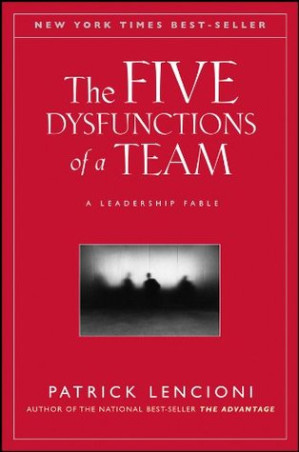Insights from The Five Dysfunctions of a Team
This book, presented as a leadership fable, delves into the core issues that impede teamwork and provides actionable insights to overcome these challenges. I chose this book to gain a deeper understanding of team dynamics and to find practical strategies to foster a more collaborative environment. You can expect to gain a comprehensive framework for identifying and addressing the common pitfalls that teams face, ultimately leading to improved performance and unity.

Summary
Lencioni introduces the concept of team dysfunctions and sets the stage for the fable. He explains how the book aims to provide a practical framework for overcoming common team challenges through storytelling and actionable advice.
The Fable
Luck
The fable begins with the story of DecisionTech, a Silicon Valley company facing significant challenges. Kathryn Petersen, the newly appointed CEO, is tasked with turning the company around. The narrative style makes it engaging and relatable, allowing readers to see the dysfunctions in action.
Part One: Underachievement
Kathryn observes the team’s lack of cohesion and struggles to understand the root causes. The initial phase focuses on diagnosing the team’s issues and setting the groundwork for improvement.
Part Two: Lighting the Fire
Kathryn starts addressing the team's issues by fostering trust among the members. This part emphasises the importance of vulnerability and open communication to build a solid foundation of trust.
Part Three: Heavy Lifting
With trust established, the team moves on to tackling conflict and commitment. Kathryn encourages healthy conflict to surface different opinions and achieve genuine commitment to decisions.
Part Four: Traction
The final part focuses on accountability and results. The team learns to hold each other accountable and maintain a collective focus on results, leading to significant improvements in performance and cohesion.
The Model
An Overview of the Model
Lencioni provides a detailed explanation of the Five Dysfunctions Model: absence of trust, fear of conflict, lack of commitment, avoidance of accountability, and inattention to results. This section summarises the key concepts introduced in the fable.
Team Assessment
A practical tool for assessing the health of a team based on the Five Dysfunctions Model. It includes questions and exercises to help teams identify their specific areas of improvement.
Understanding and Overcoming the Five Dysfunctions
Lencioni offers actionable advice and strategies for overcoming each dysfunction. He provides real-world examples and practical tips to help teams implement the concepts discussed in the book.
Key Takeaways
1. Trust is the Foundation
- Explanation: Building trust requires vulnerability and openness among team members. It involves sharing personal histories, admitting mistakes, and being willing to ask for help.
- Personal Reflection: This takeaway resonated with me deeply, as I realised that reluctance to show vulnerability can hinder teams ability to connect and collaborate. Embracing vulnerability can transform team dynamics.
- Quote: “Great teams do not hold back with one another. They admit their mistakes, their weaknesses, and their concerns without fear of reprisal.” – Patrick Lencioni (p. 44)
2. Embrace Constructive Conflict
- Explanation: Healthy conflict, rooted in trust, allows teams to engage in passionate debates about ideas, leading to better solutions and innovation.
- Personal Reflection: This concept challenged my preconceived notion that conflict is inherently negative. I've started to encourage open discussions in my team, leading to more robust and creative outcomes.
- Quote: “When there is trust, conflict becomes nothing but the pursuit of truth, an attempt to find the best possible answer.” – Patrick Lencioni (p. 202)
3. Commitment Through Clarity
- Explanation: Commitment follows healthy conflict when team members have aired their opinions and understood the collective decision. Clear communication and alignment are crucial.
- Personal Reflection: You will will notice a significant improvement in teams commitment levels after ensuring that everyone feels heard and understands the final decision.
- Quote: “When people don't unload their opinions and feel like they've been listened to, they won't really get on board.” – Patrick Lencioni (p. 207)
4. Accountability is Essential
- Explanation: Team members must hold each other accountable to maintain high standards and ensure alignment with team goals.
- Personal Reflection: Introducing a culture of accountability in teams will lead to higher performance and a greater sense of responsibility among members.
- Quote: “The enemy of accountability is ambiguity.” – Patrick Lencioni (p. 213)
5. Focus on Collective Results
- Explanation: Teams must prioritise collective goals over individual agendas to achieve true success.
- Personal Reflection: Shifting the focus to collective results will improve teams overall performance and cohesion. It has helped to move away from siloed efforts and towards a unified direction.
- Quote: “To avoid distractions, the team must remain focused on its collective results.” – Patrick Lencioni (p. 220)
Personal Reflections
Reading "The Five Dysfunctions of a Team" has impacted my approach to leadership and teamwork. It has provided me with a clear framework to diagnose and address issues within my team. The emphasis on trust and open communication has shifted my perspective, encouraging me to foster an environment where team members feel safe to express themselves. This book has not only offered practical strategies but also inspired a change in how I view and handle team dynamics.
Conclusion
Overall, "The Five Dysfunctions of a Team" is a must-read for anyone looking to enhance team performance and cohesion. Patrick Lencioni's engaging storytelling and practical insights make complex concepts accessible and actionable. Whether you're a seasoned leader or new to managing teams, this book offers valuable lessons that can lead to significant improvements in teamwork and productivity. I highly recommend it for its profound impact on both personal and professional levels.